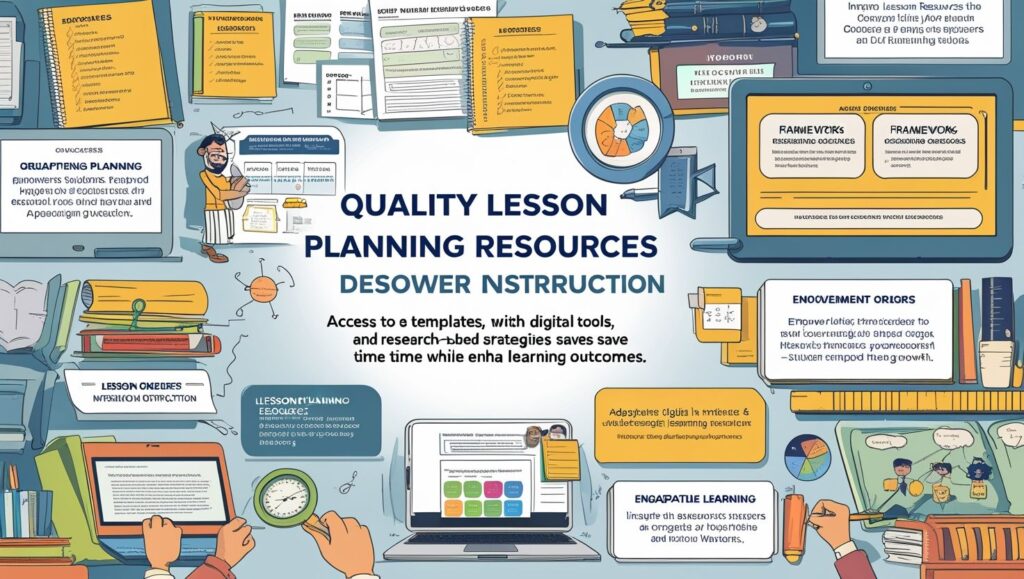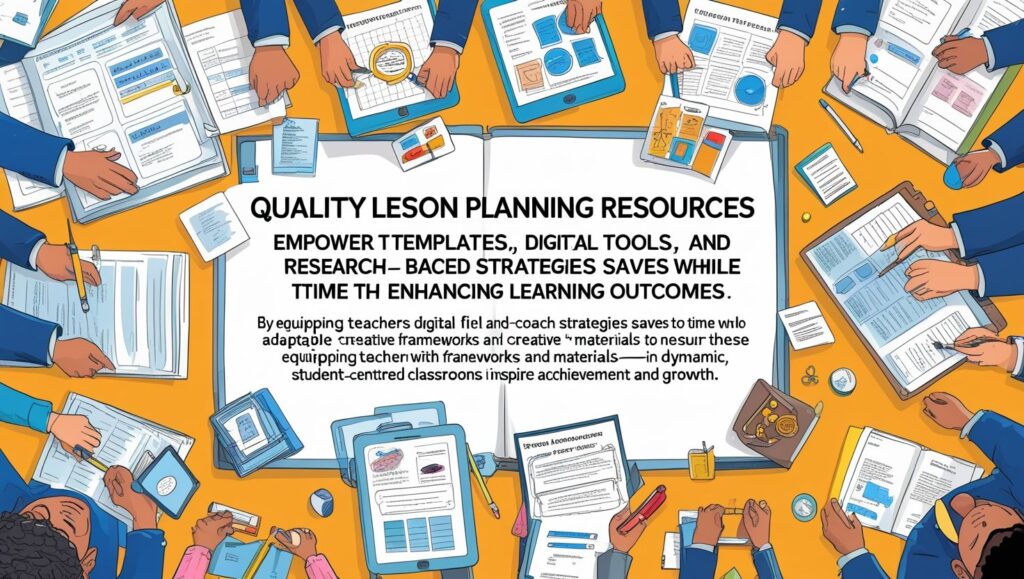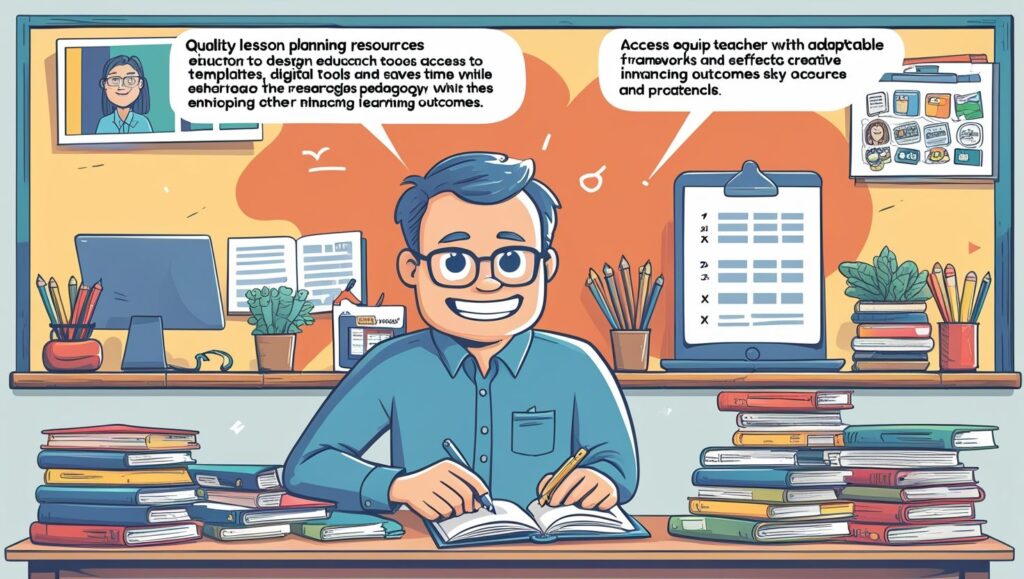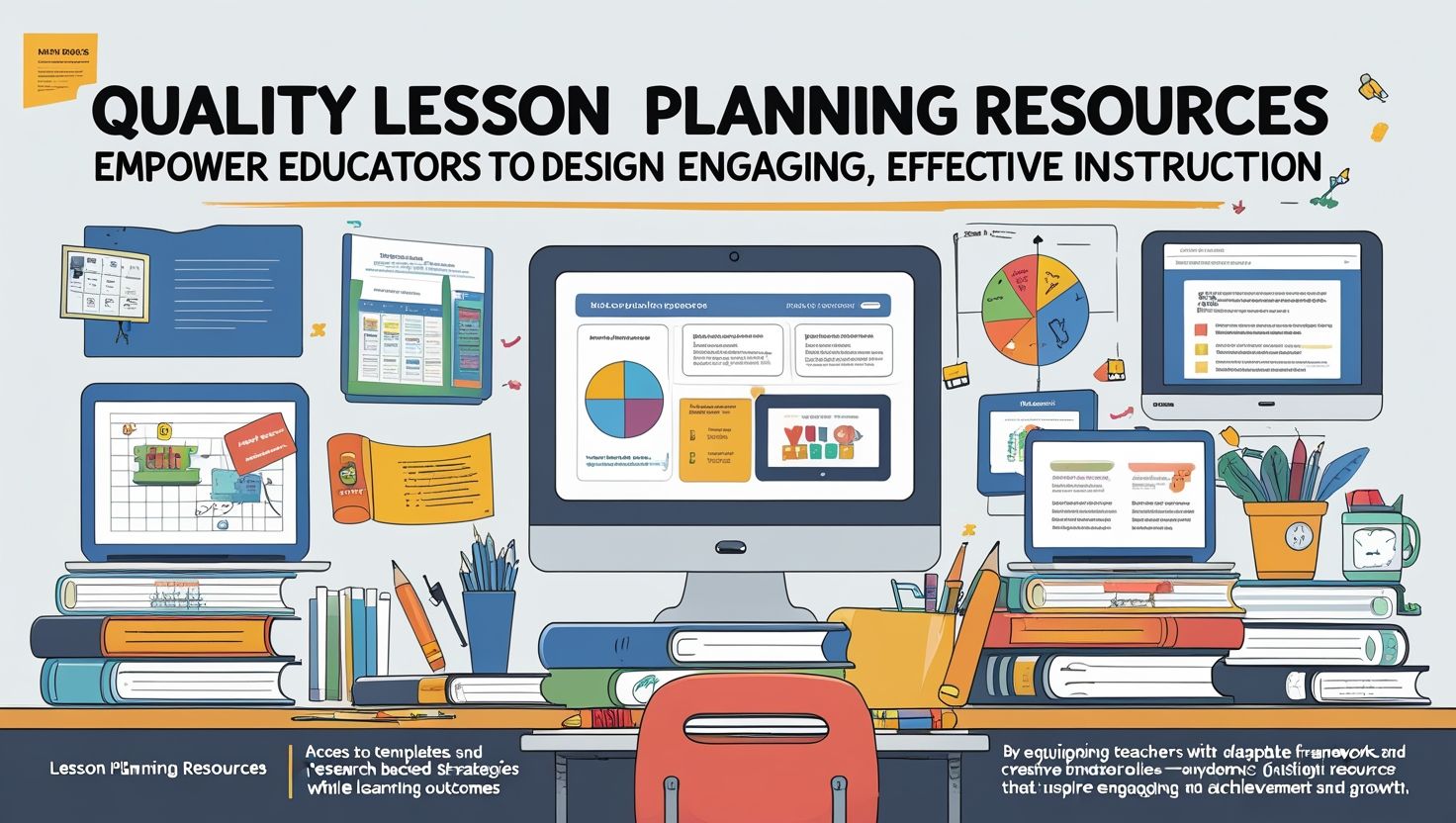1. Introduction
Empowering Educators with Lesson Planning Resources, Effective lesson planning lies at the heart of quality teaching. When teachers map out objectives, strategies, assessments, and resources, learning becomes intentional, aligned, and student-centered. A well-crafted lesson plan serves as a roadmap—guiding instructors through each stage while enabling them to respond flexibly to student needs. Studies show that thoughtful planning enhances academic outcomes, boosts teacher confidence, and reduces stress. As education shifts toward differentiated instruction, formative assessment, and learner autonomy, planning becomes more complex yet more essential. Access to high-quality resources—templates, standards alignment tools, digital content libraries, and peer examples—empowers educators to design lessons that meet rigorous goals and engage diverse learners. This article explores 18 facets of lesson planning resources, from core components and platforms to emerging AI tools, offering practical guidance at every step.
2. Core Components of Lesson Plans
A robust lesson plan integrates learning objectives, instructional strategies, materials, assessment methods, and time allocation. Experts frame it as a “roadmap” to student learning Objectives clarify what students should know or do by lesson end. Instructional strategies include teacher-led, collaborative, inquiry-based, and hands-on activities. Materials might be printouts, multimedia, manipulatives—aligned in advance to avoid disruptions. Assessment ranges from quizzes and exit tickets to discussions and projects. Finally, time management ensures pacing keeps students engaged without digressing. Using standardized templates—like those on ReadWriteThink or The Teacher’s Guide—helps ensure consistency and completeness When each component is well planned, lessons become purposeful, accessible, and more adaptable to real classroom dynamics.
3. Standards Alignment Tools
Aligning lessons with curriculum standards is vital. Websites like ReadWriteThink tag lessons to Common Core and NCTE standards, showing objective coverage wgu.edu. Educators can also use district-specific alignment tools or widgets built into LMS platforms. These resources help teachers ensure lessons are rigorous, grade-appropriate, and auditable. They also facilitate cross-curricular planning and support for students needing interventions. Additionally, planning tools like LessonPlanner (from recent AI research) can generate standards-based suggestions automatically arxiv.org. Teachers benefit from visibility into standards coverage and assessment alignment, making their lesson plans transparent to stakeholders and evaluators while ensuring student learning is goal-oriented.

4. Free Online Lesson Plan Libraries
A wealth of free lesson plans is available online. Platforms such as ReadWriteThink, PhET, Scholastic, Stanford History Education Group, PBS LearningMedia, and ShareMyLesson offer thousands of ready-to-use plans These platforms provide complete plans with objectives, materials, pacing guides, and sometimes slide decks. They cover diverse subjects (literacy, STEM, social studies, arts) and are suitable for multiple grade levels. Teachers save prep time by adapting available plans rather than starting from scratch. Many include standards mapping, differentiation tips, and engagement strategies. Using these thoughtfully saves time, supports novice teachers, and encourages adaptation over recreation—essential in modern education.
5. Printable and Interactive Materials
Beyond plans, high-quality worksheets, graphic organizers, SMARTBoard templates, and interactive activities are crucial. The Teacher’s Guide provides subject-specific sheets (math, reading, writing, science, social studies) and interactive SMART tools McGraw-Hill Wonders printouts assist language acquisition across multiple grades. These resources enhance planning by giving educators “ready-made” content aligned to lesson goals, freeing time for adaptation. Graphic organizers support literacy, while smartboard templates engage students digitally. Teachers can combine print and virtual resources to meet diverse needs efficiently.
6. Structured Planning for Small Group Teaching
Micro planning—tailored for small groups or workshops—brings specificity to instruction. A study on small-group session planning outlines how to structure time, group composition, materials, and feedback loops. This kind of resource supports differentiated instruction, enabling teachers to create mini-lessons that target specific skills. Materials may include group tasks, guided questions, peer collaboration tools, or specialized supports—helping teachers maximize impact during allotted time blocks. These focused plans, whether in elementary RTI sessions or secondary class groupings, offer structured engagement that’s flexible yet intentional.
7. Universally Designed Lesson Planning (UDL)
Universal Design for Learning (UDL) emphasizes multiple means of engagement, representation, and expression. Guides (e.g., Novak Education’s UDL Teacher’s Guide) include planning tools that prompt teachers to consider learner variability info.novakeducation.com. These tools help embed flexible goals, scaffolded materials, and varied assessments—ensuring accessibility for all students. Resource templates include checklists for multiple modalities, options for presenting content, and built-in opportunities for student choice. UDL planning supports differentiation, fosters equity, and aligns teaching with modern pedagogical ethics.

8. Digital Simulations and Interactive Modules
Digital platforms like PhET offer interactive STEM simulations tied to lesson activities wgu.edu. PBS LearningMedia includes real-world, standards-aligned multimedia resources wgu.edu. These enrich lesson plans by integrating proven digital content without extensive teacher curation. Simulations allow students to explore scientific phenomena in real time, while interactive videos and animations support comprehension and engagement. Lesson plans can include embed code or instructions, creating blended or flipped instruction seamlessly. These modules open possibilities for virtual labs or inquiry-based learning.
9. Research-Backed Planning Frameworks
Empirical studies underline the importance of structured planning. For example, research on lesson structure highlights how sequencing, scaffolding, and assessment integration boost student outcomes. Educational psychologists Chickering & Ehrmann note that well-planned utilization of time, techniques, and materials significantly enriches learning engagements. Incorporating such frameworks into planning ensures that lessons include introduction, modeling, guided practice, independent work, reflection, and assessment. Teachers can combine these with templates or checklists to produce instructionally sound plans that reflect best practices.
10. Lesson Planning for New Teachers
New educators benefit from curated guides and scaffolded templates. Edutopia provides a comprehensive toolkit including curriculum mapping, pacing guides, activity ideas, and peer collaboration strategies. Mentorship systems and shared planning resources are crucial for building competence. Structured formats reduce cognitive overload, while demonstrating pedagogical consistency. Incorporating planning rotations and peer reviews into induction helps novices connect theory with practice and improve motivation.
11. AI and ML-Enhanced Lesson Planning
State‑of‑the‑art tools are integrating AI into planning. Recent research highlights LessonPlanner, which uses large language models to generate lesson outlines aligned with pedagogical events (like Gagné’s 9 events) arxiv.org. These tools reduce prep workload, suggest activities, and recommend feedback methods. Educators can iteratively refine AI outputs for classroom relevance—combining expertise with efficiency. Emerging products (e.g., MagicSchool, Eduaide.AI) are likely to offer similar templates, differentiation suggestions, and scaffolded materials in context. AI can foster planning consistency and creativity, though teacher oversight remains central.
12. Peer-Shared and Community Resources
Communities like ShareMyLesson, Teachers Pay Teachers, and The Teacher’s Guide enable teacher collaboration, sharing user-generated plans and templates These platforms foster collective intelligence: vetted materials, teacher ratings, customization options, and shared experiences. Peer-reviewed plans often include implementation notes and classroom-tested modifications. Social networks and forums support contextual adaptation and creative lesson ideas grounded in real-world application.
13. Multimedia and Technology Integration
Technology enhances planning through embed-ready content and digital tools. SMARTBoard templates, virtual field-trip sites, and educational apps (from PBS LearningMedia, etc.) enrich lessons theteachersguide.comwgu.edu. Teachers can plan to incorporate flipped-classroom videos, QR-code audio guides, and multimedia timelines. Integration boosts engagement and supports different learning styles. Planning resources include tech-integration guides with device compatibility checks, licensing info, and accessibility options.

14. Template and Checklist Resources
Templates and checklists streamline planning consistency. Simple plans include objective guides, materials needed, student grouping instructions, and exit tickets. Extended versions add standards alignment, differentiation strategies, formative assessments, UDL options, and extension ideas. Templates support reflection—by prompting teachers to map challenges, student responses, and next-step adaptations. Reliable websites (CRLT, Teachers of Tomorrow) provide downloadable frameworks. Embedding checklists ensures students’ needs—like ELL support or high achiever extensions—are preemptively planned.
15. Assessment and Feedback Tools
Effective plans include formative and summative assessment tools. Digital platforms support quiz creation, polls, journals, and rubrics that integrate into the planning template. Resources like Google Forms, Kahoot!, and exit-ticket slides align with lesson objectives and feed next-day strategies. Resources from ReadWriteThink, PBS, and Edutopia often include prompts and rubrics. A well-planned cycle incorporates “check for understanding” moments and defines when and how teachers will provide feedback—complete with sample questions and peer-assessment strategies.
16. Differentiation and Tiered Instruction
Lesson plans should include differentiation tiers—task, text complexity, support, and pacing. Resources like UDL guides support this structure. Teachers can access leveled worksheets (e.g., from Scholastic, The Teacher’s Guide) and scaffolded tools. Templates allow planning alternative activity tracks for learners at various levels. Planning for extension challenges, remediation sessions, and peer tutoring ensures every learner progresses. Tiered lesson planning resources guide how to embed these variations intentionally, improving equity and engagement.
17. Reflection and Revision Tools
Lesson planning is iterative: planning is followed by execution, reflection, and revision. Resources prompt teachers to write reflections: What worked? What didn’t? How did student responses inform next steps? Some digital planners include reflection prompts at the end of lessons. Others suggest peer-sharing or mentor review. Research indicates that sustained reflection, prompted by structured tools, leads to continually improving instruction Embedding reflection builds a growth mindset and evidence-based improvement cycle.
18. Conclusion and Future Directions
An effective lesson plan is much more than a schedule—it’s a comprehensive, standards-aligned, differentiated roadmap that integrates pedagogy, resources, and assessment. Teachers today have a rich ecosystem of planning tools: free libraries, digital materials, structured templates, community resources, and even AI-driven supports. As education evolves, planning systems will increasingly include real-time analytics, voice-driven assistants, and personalized student profiling. However, effective teaching remains rooted in human insight—teachers interpreting context and adjusting in real time. By leveraging quality resources—from UDL templates to digital simulations—educators empower themselves and their students. The goal is not to follow one template but to build lessons that are engaging, inclusive, meaningful, and reflective—anchored in purposeful design and enriched by collaboration and innovation.

Hi this is somewhat of off topic but I was wondering if blogs use WYSIWYG editors or if you have to manually code with HTML. I’m starting a blog soon but have no coding knowledge so I wanted to get advice from someone with experience. Any help would be greatly appreciated!
You really make it appear really easy with your presentation but I in finding this topic to be really something that I think I’d never understand. It kind of feels too complex and very broad for me. I’m looking forward in your subsequent publish, I?¦ll try to get the dangle of it!
Este site é realmente fabuloso. Sempre que acesso eu encontro coisas diferentes Você também pode acessar o nosso site e descobrir mais detalhes! Conteúdo exclusivo. Venha saber mais agora! 🙂
Dead composed written content, thanks for entropy.
Thank you for the sensible critique. Me & my neighbor were just preparing to do a little research on this. We got a grab a book from our area library but I think I learned more from this post. I am very glad to see such magnificent information being shared freely out there.
I?¦ll right away grasp your rss as I can not to find your email subscription link or e-newsletter service. Do you have any? Please allow me know in order that I may subscribe. Thanks.
I keep listening to the news update speak about getting boundless online grant applications so I have been looking around for the top site to get one. Could you advise me please, where could i get some?
Thank you for any other excellent post. Where else could anyone get that kind of info in such a perfect way of writing? I have a presentation subsequent week, and I am on the search for such info.
You can certainly see your enthusiasm in the paintings you write. The sector hopes for even more passionate writers such as you who aren’t afraid to say how they believe. All the time go after your heart. “Golf and sex are about the only things you can enjoy without being good at.” by Jimmy Demaret.
Hello there, I discovered your blog by means of Google while searching for a related matter, your web site came up, it seems good. I’ve bookmarked it in my google bookmarks.